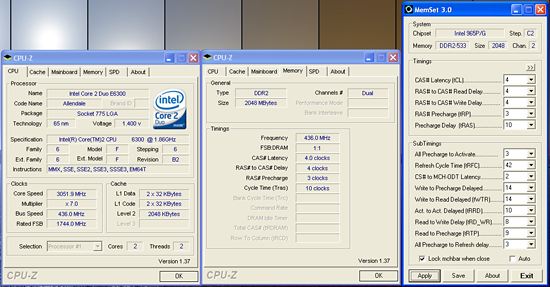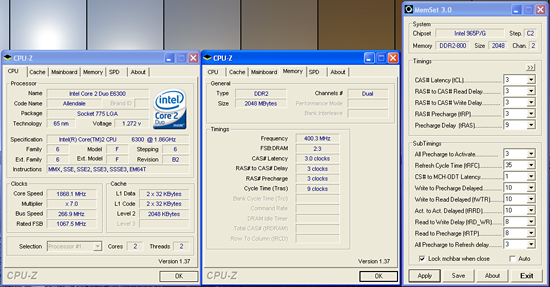Intel P965: Mid-Range Performance Sector Roundup
by Gary Key on October 20, 2006 9:00 PM EST- Posted in
- Motherboards
Abit AB9-Pro: Overclocking
FSB Overclocking Results
Our E6300 posted very good results when compared to our earlier overclocking test results that resulted in a maximum FSB speed of 366. However, the 7x436FSB level is the lowest of our test group today and does not match up to the promise of this board's performance. We also have an issue with our CPU requiring 1.4375V on this board to reach a stable 3.05GHz. We normally only require 1.40V in order to reach this level and noticed the board would not boot without an increase to 1.4375V although it was rock stable at this setting. Vdroop averaged around .02V to .03V during overclocking and heavy system loads. Our memory is usually very stable up to DDR2-900 at 4-3-3-10 settings but required slightly looser timings on this board. Although the overclocking results are not as high as our other boards, the ability to now run up to 436FSB in a stable manner is fine for the majority of people who want to overclock.
Memory Stress Testing
Memory stress tests look at the ability of the Abit AB9-Pro to operate at the official DDR2-800 memory frequency at the best performing memory timings our GEIL PC2-6400 can achieve on this board.
The Abit AB9-Pro was very stable with 2 DDR2 modules in Dual-Channel mode at the settings of 3-3-3-9 at 2.2V with the 1.4 and above BIOS. By increasing the voltage to 2.25V we could run at 3-3-3-6 timings although there were not any real performance improvements unless we utilized MemSet to change other latency settings.
We had to change our timings to 3-4-3-10 from 3-3-3-9 when installing two additional modules. We were able to keep our voltage set to 2.20V at this setting. We were able to maintain these settings up to a 7x405FSB, DDR2-810, setting with 2.30V. Our maximum overclock with four DIMMs installed was 7x418FSB, DDR2-836 4-4-3-12, with the memory set at 2.30V. Once again, we had to use BIOS 1.4 or higher in order for these settings to work.
In fact, on the first two BIOS releases this particular memory would not even boot when installed in this board. The memory itself is designed to run at 2.0V or higher depending upon the latencies selected. GEIL actually rates this memory at 2.4V for 3-4-3-8 operation at DDR2-800 although we have not required voltages above 2.2V at this setting.
FSB Overclocking Results
| Abit AB9-Pro Overclocking Testbed |
|
| Processor: | Intel Core 2 Duo E6300 Dual Core, 1.86GHz, 2MB Unified Cache 1066FSB, 7x Multiplier |
| CPU Voltage: | 1.4375V (default 1.3250V) |
| Cooling: | Scythe Infinity Air Cooling |
| Power Supply: | OCZ GameXStream 700W |
| Memory: | Geil PC2-6400 800MHz Plus (2x1GB- GX22GB6400PDC) (Micron Memory Chips) |
| Video Cards: | 1 x MSI X1950XTX |
| Hard Drive: | Seagate 320GB 7200RPM SATA2 16MB Buffer |
| Case: | Cooler Master CM Stacker 830 |
| Maximum CPU OC: (Standard Ratio) |
436x7 (4-4-4-12, 1:1, 2.3V) 3052MHz (+64%) |
| . | |
 |
| Click to enlarge |
Our E6300 posted very good results when compared to our earlier overclocking test results that resulted in a maximum FSB speed of 366. However, the 7x436FSB level is the lowest of our test group today and does not match up to the promise of this board's performance. We also have an issue with our CPU requiring 1.4375V on this board to reach a stable 3.05GHz. We normally only require 1.40V in order to reach this level and noticed the board would not boot without an increase to 1.4375V although it was rock stable at this setting. Vdroop averaged around .02V to .03V during overclocking and heavy system loads. Our memory is usually very stable up to DDR2-900 at 4-3-3-10 settings but required slightly looser timings on this board. Although the overclocking results are not as high as our other boards, the ability to now run up to 436FSB in a stable manner is fine for the majority of people who want to overclock.
Memory Stress Testing
 |
| Click to enlarge |
Memory stress tests look at the ability of the Abit AB9-Pro to operate at the official DDR2-800 memory frequency at the best performing memory timings our GEIL PC2-6400 can achieve on this board.
| Abit AB9-Pro Stable DDR2-800 Timings - 2 DIMMs (2/4 slots populated - 1 Dual-Channel Bank) |
|
| Clock Speed: | 800MHz |
| CAS Latency: | 3 |
| RAS to CAS Delay: | 3 |
| RAS Precharge: | 3 |
| RAS Cycle Time: | 9 |
| Voltage: | 2.20V |
The Abit AB9-Pro was very stable with 2 DDR2 modules in Dual-Channel mode at the settings of 3-3-3-9 at 2.2V with the 1.4 and above BIOS. By increasing the voltage to 2.25V we could run at 3-3-3-6 timings although there were not any real performance improvements unless we utilized MemSet to change other latency settings.
| Abit AB9-Pro Stable DDR2-800 Timings - 4 DIMMs (4/4 slots populated - 2 Dual-Channel Bank) |
|
| Clock Speed: | 800MHz |
| CAS Latency: | 3 |
| RAS to CAS Delay: | 4 |
| RAS Precharge: | 3 |
| RAS Cycle Time: | 10 |
| Voltage: | 2.20V |
We had to change our timings to 3-4-3-10 from 3-3-3-9 when installing two additional modules. We were able to keep our voltage set to 2.20V at this setting. We were able to maintain these settings up to a 7x405FSB, DDR2-810, setting with 2.30V. Our maximum overclock with four DIMMs installed was 7x418FSB, DDR2-836 4-4-3-12, with the memory set at 2.30V. Once again, we had to use BIOS 1.4 or higher in order for these settings to work.
In fact, on the first two BIOS releases this particular memory would not even boot when installed in this board. The memory itself is designed to run at 2.0V or higher depending upon the latencies selected. GEIL actually rates this memory at 2.4V for 3-4-3-8 operation at DDR2-800 although we have not required voltages above 2.2V at this setting.










62 Comments
View All Comments
smn198 - Monday, October 23, 2006 - link
Would you be able to re-run using 4 drives for all of the tests please?
jonp - Sunday, October 22, 2006 - link
-- “…budget sector and includes boards from ECS, Foxconn, Intel, and Gigabyte.” – will the MSI P965 Neo-F be in this set?-- the Abit AB9 Pro feature set does not show the eSata port on the SI 3132 (two SATA). it does show a serial port on the i/o panel but not one in the picture.
-- The Biostar feature set shows 4 USB on the i/o panel when there are six in the picture.
JarredWalton - Sunday, October 22, 2006 - link
Fixed - thanks.powchi - Saturday, October 21, 2006 - link
Can I use a 20-pin power supply on these boards since all are using 24-pin connectors? Or will I be needing 20pin to 24pin adaptor?The PSU is an Enermax NoiseTaker EG475P-VE SFMA 470W ATX 12V v1.3.
Aikouka - Sunday, October 22, 2006 - link
Some motherboard manufacturers will no longer support your motherboard if they find out you've been running it with a 20-pin ATX plug or a 20->24-pin adapter. Just be safe and get a newer PSU :). I know DFI will no longer support the motherboard if it specifically asks for a 24-pin.JarredWalton - Saturday, October 21, 2006 - link
Technically, yes you can use 20-pin PSUs. Will they work, and will the system be stable? That varies. I haven't had any issues on the systems where I've done it, but if you do high overclocking it will likely become a serious issue.powchi - Saturday, October 21, 2006 - link
Jarred,So there's no need to use a 20pin to 24pin adaptor? What are the differences when using and not using an adaptor? Thanks.
lopri - Sunday, October 22, 2006 - link
No. As a matter of fact, the adapter should be avoided. Just plug the 20-pin connector to 24-pin receptacle with 4-pin left empty. Like Jarred said, it should work in theory and it does in practice. However, the quality of PSU and how intense is one's OC can affect the (long-term) stability.JarredWalton - Sunday, October 22, 2006 - link
I suppose the adapter *could* help, as it ensures power is available on all the 24-pins, but you're still taking the power from the same source so depending on how that works out it can actually make things worse. I would typically say that if you have a 400W or better PSU you should be fine with little to moderate OC'ing even with 20-pins. (I have an OCZ ModStream 450W that certainly works fine in a 939 board with a decent 2.0 to 2.6 GHz overclock.)lopri - Sunday, October 22, 2006 - link
Yes! Not to brag about myself or anything, but I went through countless Socket 939 Opterons on DFI NF4 SLI-D with original Antec TruePower EPS12V (20-pins, not the TP2 with 24-pins) including an Opteron 165 @3.0GHz (9x333). TCCD up to 325MHz/2.5-4-3-8! The setup was absolutely stable.